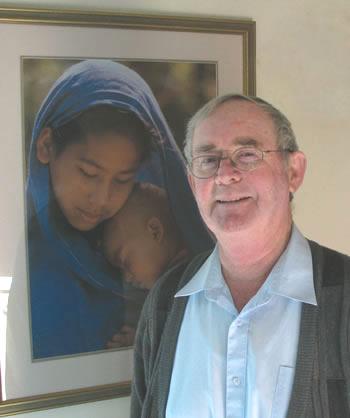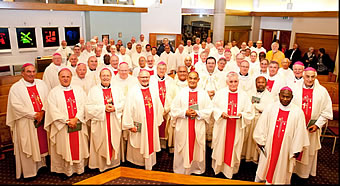Churches of the Pacific
On May 12th the Federation of Catholic Bishops’ Conferences of Oceania met in Wellington.
There was a gathering of more than 80 bishops. In an insightful homily (on page 47) Bishop Charles Drennan points to the power of the Holy Spirit working with parish structures. The Church in New Zealand began with many threads converging but one of significance was a series of pleas by Thomas Poynton in the 1830’s.
Thomas and his family lived in the Hokianga. He was a timber merchant and much of his trade was done through Sydney. In the course of having their children baptised in Sydney, he and his wife Mary renewed their pleas for a priest to live in New Zealand. Archbishop Polding was unable to supply a priest but he was able to send their plea for priests for New Zealand to Rome.
In 1838 Bishop Pompallier and the Marist priests and brothers arrived to establish the Church in New Zealand. Their primary work was with the Maori. Bishop Pompallier’s brief was also to establish the Church in the scattered islands of the Western Pacific. By the mid 1840’s the scope of his activity was confined to New Zealand. The Marists were to continue with the evangelisation of the Western Pacific. The story of their efforts is still being written.
It is a story of European priests, brothers, sisters and lay people setting out to evangelise. Soon it became a story of local people catechising their neighbours. All sought in their own way to further the message of the Good News.
This involved the learning of local languages and customs and gaining the trust of the local people. Schools and hospitals were part of the Mission outreach. Dioceses were established and local vocations were encouraged. Gradually a local Church grew in the Pacific.
The European settlers of Australia and New Zealand were able to establish themselves first and gradually Island Churches also were, and with that came local Bishops.
The gathering in Wellington celebrates the work the Holy Spirit began all those years ago. The Bishops present represent their priests, religious and laity. Each Church faces their own challenges and each is searching for its own answers.
The topics for the plenary sessions make interesting reading. They run from the Australian Immigration Policy to dealing with Pastoral Planning and Earthquakes to Reading the Signs of the Fiji Times.
The family of the Churches of Oceania has faced formidable challenges in the past. Who knows what lies in the future? One thing is for certain, with the strength of the Holy Spirit and the generosity of the people we can look forward with optimism to future gatherings of Oceanian Bishops.


 Entries(RSS)
Entries(RSS)